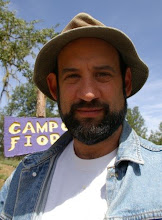Thursday, December 30, 2010
Ice-ya!
This morning I got up at 7am to check if things dried out. It was 30 degrees, and all was frozen. All went much smoother today! So I got my ice-nine after all. And it didn't freeze the oceans!
Wednesday, December 29, 2010
The Cat's Cradle
 Got ice-nine?
Got ice-nine?I could have used some today. I was trying to get a three day irrigation project completed today, but the rain last night turned everything into a slurry.
Even the tracks on this baby were getting gummed up. I can see why the military in Kurt Vonnegut's novel wanted to find something to solidify the mud. If only it didn't freeze the oceans!
I tried trenching the cave-ins by hand, but the pea soup that used to be earth just stuck to the shovel and turned them into 50 lb weights on poles.
As if the hip deep mud weren't enough, I think it was the hail that finally caused me to call it a day. The rain was supposed to peter out by the afternoon. But it's after 2 and still raining sideways.
Sigh... Wish I didn't have anything to get DONE today!
Sunday, April 11, 2010
 These last few weeks, Carmel Lavender has been working hard bringing more lavender to Carmel Valley.
These last few weeks, Carmel Lavender has been working hard bringing more lavender to Carmel Valley.Here in the photo is foreman Alfonso, Jose, Nick, Jay, Nico, Charlie, and Eliodoro standing in the new median field. In a couple of months the hundreds of plants will begin spiking lavender turning this avenue into a purple dream.
This field was prepped by ripping to a depth of 2 feet, which brought up a lot of the roots. And then disked. But each plant had to be hand placed. Drip irrigation lines were run down the rows subsequently. But lately irrigation has not been necessary. Mother nature has been taking care of that quite handily.
Hive Building Time
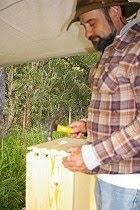 This weekend, I am building bee hives. More bees are coming in about a week. So I have to get their homes assembled and painted before they arrive. The weather is making this challenging however. This spring has been fairly wet for this area. That's great for the plants. But not so great if you have things to get done outside. For example building and painting bee hives.
This weekend, I am building bee hives. More bees are coming in about a week. So I have to get their homes assembled and painted before they arrive. The weather is making this challenging however. This spring has been fairly wet for this area. That's great for the plants. But not so great if you have things to get done outside. For example building and painting bee hives.So the first thing I did was try to make a covered area where I can work in a light rain. I got a cotton drop cloth. Cotton, not plastic. Cotton isn't waterproof, but hopefully will shed a light rain. Unfortunately those plastic tarps are an ecological disaster. They don't last forever. Then they start flaking into little pieces that wind up all over the planet. Nope. I'll try my luck with cotton. I hung this out behind my lavender workshop and leveled the area a bit. Then I set up two 2x6 rails on which to set the newly assembled hives for painting.
 In the picture above, you can see me putting one of the hive super boxes together. They are already cut. I just need to glue the corners, and then put screws to hold them firm. Once they are all built, I stack them on the rails for painting along with the bottom boards, lids, and stands. Here I am enjoying my new outdoor hive workshop!
In the picture above, you can see me putting one of the hive super boxes together. They are already cut. I just need to glue the corners, and then put screws to hold them firm. Once they are all built, I stack them on the rails for painting along with the bottom boards, lids, and stands. Here I am enjoying my new outdoor hive workshop!When I finish assembling, I paint! Unfortunately the sprinkling has started. Cold weather is not the best to paint in. But I suppose the show must go on. At this point, it is still cold enough I wish I could wait an extra week for things to warm up. Would be better for the bees too. Nice for them to have good weather when they start their new colony. Of course, the rain should mean there will be plenty of flowers for them to forage from when it does warm up.
Everything has it's benefits and nuisances. I guess there is something to be said for having a really big barn! Maybe someday.
Tuesday, March 9, 2010
Moving Day for Chicken
 The wheat I planted in the fall is finally starting to look substantial. I wish it were a little thicker actually, but the chickens have been HUNGRY! I suppose with the cold air they need their calories. Well I have had the chicken tractor parked for a while waiting for the wheat to grow thicker. But I felt this week it was time to move, and let the chix graze on the new wheat grass.
The wheat I planted in the fall is finally starting to look substantial. I wish it were a little thicker actually, but the chickens have been HUNGRY! I suppose with the cold air they need their calories. Well I have had the chicken tractor parked for a while waiting for the wheat to grow thicker. But I felt this week it was time to move, and let the chix graze on the new wheat grass.If you are new to my blog and haven't read my previous stories about my chickens, let me provide a brief overview. My chickens live in a mobile chicken coop that you can see to the right on the far right of the photo. The coop protects them from the elements, and just as important, PREDATORS! However it is important for the hens to be able to get to the ground. To eat growing plants and bugs in the soil. So the purple beast to the left in the photo is the chicken tractor that attaches to the coop. These can be moved as the chickens eat their way through the ground beneath.
I move each part, the chicken tractor and the coop, separately. They are detached by removing the bridge tunnel. Then the chicken tractor is jacked up and the wheels deployed. The coop is just pulled. Both by tractor. Once they are moved and aligned, the bridge is reattached and the chickens let loose.
 Here you can see the happy chickens foraging on the newly available grass. They absolutely LOVE fresh ground. They had so much fun eating the plants and rolling in the fresh earth. I came back about mid-day to find a dozen hens taking dirt baths in the fresh soil. They sure looked happy!
Here you can see the happy chickens foraging on the newly available grass. They absolutely LOVE fresh ground. They had so much fun eating the plants and rolling in the fresh earth. I came back about mid-day to find a dozen hens taking dirt baths in the fresh soil. They sure looked happy!I hope all of this helps their egg production. With the cold weather, they have been a little slow these past couple of weeks. People want eggs ladies! Try not to rest all day ;)
Sunday, February 21, 2010
Lavender Vanilla Custard Pie
 Lavender is a wonderful herb to cook with. Many people do not think of food when they think of lavender. But when used properly, it can be a very nice herb.
Lavender is a wonderful herb to cook with. Many people do not think of food when they think of lavender. But when used properly, it can be a very nice herb.One of my most favorite combinations in lavender and vanilla. These two combine on the palate in such a way that the result is greater than the sum of the two flavors. Most amazing.
Today Carolyn, a friend and star of the video Distilling Lavender Essential Oil (click here to watch video) had her annual pie party. Last year I brought my other lavender-vanilla favorite: ice cream. But it is a pie party after all. So I decided to think about putting lavender into a pie. My inspiration came from a lavender vanilla creme burlee that I have heard about, but never tried. I thought, a lavender-vanilla custard pie would be a wonderful variation.
The recipe is simple. I made my tried and true crust using whole wheat white flower and organic butter for shortening. Then for the custard, it was: 3 eggs (I used eggs from my hens here on the farm), 3/4 cup of sugar, 1/4 tsp salt, and 2 1/2 cups cream, 8oz of cream cheese, a table spoon of vanilla, and of course about a half cup of culinary lavender buds (courtesy of Carmel Lavender). First I scalded the milk. While I was heating it, I allowed the lavender buds to soak in a strainer on top. This makes a lavender cream 'tea'. I allowed about 10 minutes on the stove to keep the cream hot, stirring frequently to keep it from burning, and pressing the lavender from time to time. I also put the cream cheese into the milk to let it melt. Then I mixed the sugar and salt, beat the eggs, and added the eggs to the sugar salt. Next I stirred into the sugar/salt/egg mixture the vanilla. Finally I added the lavender cream mixture and beat with an electric beater. This was poured into the pie shells and baked for about 45 minutes, checking frequently after about 20 minutes.
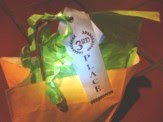 For my first lavender-vanilla custard pie, it came out great! I took 3rd place in the non-fruit category of the pie contest! I was actually honored. There were almost 40 pies. And they were all quite wonderful. Some were in fact amazing.
For my first lavender-vanilla custard pie, it came out great! I took 3rd place in the non-fruit category of the pie contest! I was actually honored. There were almost 40 pies. And they were all quite wonderful. Some were in fact amazing. Take a look at this pie that took second in the category. This was a honey chiffon pie with an apricot marmalade glaze. The crust was a no-bake crust made from vanilla wafer cookies. They hand made each of the little bees out of dark and white chocolate with almond slivers for the wings. They made the honey comb pattern by pressing and freezing bubble wrap into the custard. Quite creative. And I must admit, it tasted fabulous. There is Wendy and Pam receiving their well deserved 2nd place prize from Carolyn.
Take a look at this pie that took second in the category. This was a honey chiffon pie with an apricot marmalade glaze. The crust was a no-bake crust made from vanilla wafer cookies. They hand made each of the little bees out of dark and white chocolate with almond slivers for the wings. They made the honey comb pattern by pressing and freezing bubble wrap into the custard. Quite creative. And I must admit, it tasted fabulous. There is Wendy and Pam receiving their well deserved 2nd place prize from Carolyn.Since I raise bees, I particularly liked this one :)
First place was a chocolate caramel macadamia nut pie that was quite intense. It is really hard to top that combination!
In the end, Chef Chaz from the Big Sur River Inn judged best of show. This went to a French apple with a walnut crust.
Now the hard part, trying to sleep after tasting so many pies! I must say, half way through the tasting, I thought I'd pass out from the sugar rush :) Night now!
Wednesday, February 10, 2010
Variety Includes Baked Bread
CSA Variety Now Includes Yummy Baked Bread!
The Co-op continues to look for new producing members that compliment the variety offered in our CSA Variety Box.
This year, we are pleased to welcome Roxana, owner and baker at the local Carmel Valley Wild Goose Café and Bakery.
Today’s box includes a one-pound loaf, baked fresh this morning in her Carmel Valley ovens. It is a whole wheat bread that includes multiple grains wheat, oats, and millet and flax seed. Roxana sprouts her own spelt and wheat and adds these healthy ingredients to her bread as well.
The Wild Goose Café and Bakery is located at 18 East Carmel Valley Road in Carmel Valley Village.
If you decide to make a trip ‘downtown’ you find other delicious baked goods, coffees and teas.I stopped by yesterday to say hello, and got to sample some of her rye bread, which was fabulous. A couple of weeks ago, I was treated to her home-made panna cotta. Oh my! Drizzled in berry sauce. It was so delicious, I could hardly see while I was eating it! That flavor is something I will remember in my final moments on Earth :)
She also has gluten free options including an amazing blueberry muffin made with rice flour, yogurt, and egg whites, and an entirely vegan rice flour banana bread.
Earlier this year, Roxana experimented with some of this year’s culinary lavender crop and made some lavender shortbreads! I am looking forward to sharing these with you through your Carmel Valley Co-op Variety Box in the future.If you are not a Carmel Valley Co-op Variety CSA member, please go to www.carmelvalleycoop.org and sign-up!
The Co-op continues to look for new producing members that compliment the variety offered in our CSA Variety Box.
This year, we are pleased to welcome Roxana, owner and baker at the local Carmel Valley Wild Goose Café and Bakery.
Today’s box includes a one-pound loaf, baked fresh this morning in her Carmel Valley ovens. It is a whole wheat bread that includes multiple grains wheat, oats, and millet and flax seed. Roxana sprouts her own spelt and wheat and adds these healthy ingredients to her bread as well.
The Wild Goose Café and Bakery is located at 18 East Carmel Valley Road in Carmel Valley Village.
If you decide to make a trip ‘downtown’ you find other delicious baked goods, coffees and teas.I stopped by yesterday to say hello, and got to sample some of her rye bread, which was fabulous. A couple of weeks ago, I was treated to her home-made panna cotta. Oh my! Drizzled in berry sauce. It was so delicious, I could hardly see while I was eating it! That flavor is something I will remember in my final moments on Earth :)
She also has gluten free options including an amazing blueberry muffin made with rice flour, yogurt, and egg whites, and an entirely vegan rice flour banana bread.
Earlier this year, Roxana experimented with some of this year’s culinary lavender crop and made some lavender shortbreads! I am looking forward to sharing these with you through your Carmel Valley Co-op Variety Box in the future.If you are not a Carmel Valley Co-op Variety CSA member, please go to www.carmelvalleycoop.org and sign-up!
Tuesday, February 2, 2010
Variety CSA Begins Today!
 The Carmel Valley Co-op Variety CSA begins today, February 3rd! Sign-up info is on the www.carmelvalleycoop.org website.
The Carmel Valley Co-op Variety CSA begins today, February 3rd! Sign-up info is on the www.carmelvalleycoop.org website.The Variety CSA was introduced last year. The idea is to combine the convenience of a locally produced food CSA with the variety offered from different farms in the area.
One of the favorite features of the Variety CSA are fresh eggs. No, those aren't dyed Easter eggs you see in the photo. Those are the natural colors. Nice browns, brown speckled, blue, green, tan, white. Who says eggs have to be white or brown?
 Here at Carmel Lavender, I maintain one of the flocks that supplies the eggs for the Variety CSA. I keep a broad assortment of heritage hens that lay those beautifully colored eggs you see above.
Here at Carmel Lavender, I maintain one of the flocks that supplies the eggs for the Variety CSA. I keep a broad assortment of heritage hens that lay those beautifully colored eggs you see above.This little lady, the black, grey, and white striped bird is one of those hens. She is a barred rock hen. She lays wonderful brown eggs. I also have Rhode Island Reds, Black Cornish, Buff Orpingtons, Auracanas, and a few other breeds. Each breed has different personalities. The black cornish like to have their backs scratched. The Rhode Island reds do too, to a lesser extend. The auracanas don't tend to like to be handled as much, and stay away from people. In fact, they tend to stay away from the other hens too. And the barred rocks have a nice temperament, but are not quite as forward as the black cornish hens are.
 Here you can see two buff orpington roosters. No, they don't wait until sunrise to start crowing. Usually the noise begins around 3 or 4 in the morning. I actually like the sound. Sometimes I wake up partially, but it is kinda nice to feel the life around the farm, even while you sleep. They aren't too close to the house, or it might be more disturbing. I suppose roosters in close urban quarters would require enthusiastic neighbors!
Here you can see two buff orpington roosters. No, they don't wait until sunrise to start crowing. Usually the noise begins around 3 or 4 in the morning. I actually like the sound. Sometimes I wake up partially, but it is kinda nice to feel the life around the farm, even while you sleep. They aren't too close to the house, or it might be more disturbing. I suppose roosters in close urban quarters would require enthusiastic neighbors!The roosters protect the hens. That is their job. Any time you handle a hen, you can see a nervous rooster standing by, ready to step in if needed. They also keep the eggs fertile. I keep enough roosters to ensure fertile eggs.
 The chickens have a pretty diverse diet. I feed them the vegetarian kitchen scraps. They love that. It does mean a lot less for my compost heap though. But the chicken manure goes into the compost instead. I also give them a grain based chicken feed. And important in my farm plan is to let them forage on the grasses and wild plants. Here you can see a field I sowed with wheat a few months ago. The wheat is starting to get higher. When it is ready, I will let the chickens forage on this to supplement their diets.
The chickens have a pretty diverse diet. I feed them the vegetarian kitchen scraps. They love that. It does mean a lot less for my compost heap though. But the chicken manure goes into the compost instead. I also give them a grain based chicken feed. And important in my farm plan is to let them forage on the grasses and wild plants. Here you can see a field I sowed with wheat a few months ago. The wheat is starting to get higher. When it is ready, I will let the chickens forage on this to supplement their diets.These days, while the wheat isn't quite ready, I am bringing the chickens the grasses and weeds I pull from my home vegetable garden. I just load up the wheel barrow every morning, and then dump it into the tractor. The hens go to work! They can devour an entire load in one or two days. They sure seem to have fun picking through the pile to find the tastiest weeds!
I hope you enjoyed reading about the hens. And if you are interested in eggs, please go to the website at www.carmelvalleycoop.org and sign up for the Variety CSA! In addition to eggs, you enjoy fresh organic vegetables, lavender, essential oils, soaps, and delicious olive oil. Provided by Catalan Family Farms, Carmel Lavender, Larsen Family Farms, and Carmel Valley Olive Company.
Tuesday, January 19, 2010
Staking a Field
 In the last article I talked about the baby lavender plants, all cozy and warm in their wood stove heated nursery just a few mile north. January is well underway, and it's time to start thinking about preparing a home for the children. Last week I agreed to come out today and start staking out the new fields... with none other than lavender stakes of course! But that was before I saw the weather. I woke up this morning, and yikes! She was really letting loose. I put on my hat and jacket to feed the chickens carrying an empty bucket with me. When I arrived at the coop, the bucket was full. That was how hard it was raining. I broke out my oil slicker and rubber boots for what promised to be a WET day!
In the last article I talked about the baby lavender plants, all cozy and warm in their wood stove heated nursery just a few mile north. January is well underway, and it's time to start thinking about preparing a home for the children. Last week I agreed to come out today and start staking out the new fields... with none other than lavender stakes of course! But that was before I saw the weather. I woke up this morning, and yikes! She was really letting loose. I put on my hat and jacket to feed the chickens carrying an empty bucket with me. When I arrived at the coop, the bucket was full. That was how hard it was raining. I broke out my oil slicker and rubber boots for what promised to be a WET day!The new field is going to be integrated into a functional landscape. And the terrain is not completely flat. So the field planning is a bit more complex than a simple rectangle with north-south running rows and irrigation. The first order of business is to determine exactly where the lavender are going to be planted. In this case, the landscape design company has provided me with some CAD renderings of the fields, but it is important to verify exactly where the fields are going to be, and take measurements for developing the field and irrigation plans.
Now, I have friends who's family farm cattle, corn, and wheat in Kansas. And they to a lot of their planning via satellite. In fact, it's amazing how much is done these days with technology. All those millions of dollars spent during the cold war to try to see where the nuclear missiles were going, are now helping farmers plan and manage their crops. Real whiz-bang Buck Rogers stuff. I suppose someone is still looking out for the missiles, but it's nice to know technology is being used for something constructive nowadays.
 But there is nothing better than working right on the ground. At least for me. So I broke out my really high-tech farming gear. Satellites ain't got nothing on a good measuring wheel and compass! They might not be fancy pants, but they git er done.
But there is nothing better than working right on the ground. At least for me. So I broke out my really high-tech farming gear. Satellites ain't got nothing on a good measuring wheel and compass! They might not be fancy pants, but they git er done.The work will be done in two stages. First, the field measurements. Second I'll draft up a set of field plans. Since I'm a visually oriented person, I like to have a map with me in the field while I'm taking the measurements. So I sat down this morning at the kitchen table with the CAD renderings and drew up a crude field map. I'll use this as reference. Then I hopped in the car and drove down to the site.
Now, remember the rain. Yeah, well, I'm not a duck. More importantly, without the proper writing instruments and laminated maps, trying to take notes in the middle of a biblical deluge is kinda tricky. So I have to admit, I sneaked a peak on the satellite, even though I was trying to be so Luddite. I could see that the front coming in off the ocean to the west was petering out. My estimates, I could go now and get soaked. Or wait an hour and get there during a break in the rain. Excellent. That was just the excuse to take one more cup of tea.
When I arrived, the storm tail was just passing. So I waited 10 minutes in the car for it to pass, and then got out and started my work. Using the map as reference, I picked obvious landmarks, labeled the map and took measurements. Namely distances and directions using the measuring wheel and compass. I recorded all of these for each field area on the field map.
The nice thing about being on the ground like this when marking the field is that you get a real feel for the soil and terrain. You can make adjustments for tree shade, drainage (helpful to notice when it has just rained!), buried utility boxes and sewers, as well as slope. Things that are just not present, or more difficult to feel on the satellite images. And more importantly, you get to be outside on a beautiful (albeit wet) day, wind in your face, enjoying the deer meandering by, birds, turkeys, cool mushrooms, and squirrels. Well, maybe not the squirrels (see my previous post on ground squirrels here). But you get the picture. Life couldn't be better.
Once the data was collected, I packed up the gear and headed home. Even with the rain gear, I got a bit wet. So I started a fire, took off my wet socks, and warmed up with another cup of tea. Rain started again. That's okay, we can use it.
Tuesday, January 12, 2010
Baby Lavender
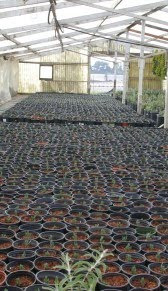 Last month, I took a trip up to Watsonville to visit my new babies. Lavender babies of course.
Last month, I took a trip up to Watsonville to visit my new babies. Lavender babies of course.This year I am partnering with a local resort to plant a brand new lavender field in Carmel Valley. This is an amazing opportunity. Not only is the lavender going to be absolutely stunning, because the field will be located on a property with regular visitors, it is going to provide a real hands-on way to share the amazing experience of growing and distilling lavender with the guests. While I enjoy sharing what I do through the website and blogs, I am looking forward to doing the same work face to face.
Well, back to the babies. This is going to be a substantial field. Several thousand plants. Here you can see some of the little plants in the greenhouse, where they will grow before they are taken into the world and planted out.
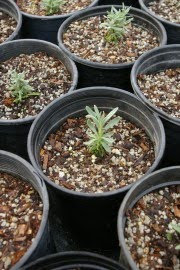 This close-up taken in December shows the baby plants in the pots where they will develop their roots. This type of lavender (grosso) is propagated through cuttings. Cuttings are taken from the mother plant, and placed in a special soil mixture, where they form roots. Once the cutting has its first roots, it is now a baby plant. These plants are then transplanted into the pots you see them in the photo. Here in these pots, they will be kept warm in a greenhouse all winter so they can develop more extensive root systems and be ready to grow big and strong in the spring.
This close-up taken in December shows the baby plants in the pots where they will develop their roots. This type of lavender (grosso) is propagated through cuttings. Cuttings are taken from the mother plant, and placed in a special soil mixture, where they form roots. Once the cutting has its first roots, it is now a baby plant. These plants are then transplanted into the pots you see them in the photo. Here in these pots, they will be kept warm in a greenhouse all winter so they can develop more extensive root systems and be ready to grow big and strong in the spring.To assure they grow to their full potential, the greenhouse is kept
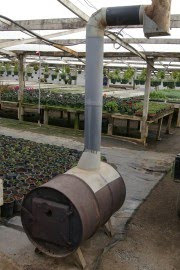
warm. Obviously the sun does a lot of the work with the clear canopy of the green house. Soil activity also contributes to the warms. And this greenhouse has an added helper, wood burning stoves. Here in this photo, you can see one of the wood burning stoves used to heat the greenhouse on the colder winter days. Pretty low tech, but it does the job. Standing next to the stove, I was actually starting to sweat!
It will be fun to check back in a month and see how our babies are doing.
Friday, January 8, 2010
Winter Bee Check
 Today I made a quick winter check of the bees.
Today I made a quick winter check of the bees.Usually in the winter, I don't worry too much about the bees. Hopefully if things were done properly in the fall, they would have stored enough food to survive. In the cold weather, they are usually balled up in the hive, and I don't like to disturb them.
Yesterday I heard from a neighbor that she had lost her hive already. The hive autopsy sounded like starvation, but there was still frames with honey in the hive. And the temperatures have been quite mild, save one or two weeks in December. So I went and sat by some of my hives. It was kind of chilly yesterday, and I did see a few bees, but not many. Today it was warmer, so I decided to take another look.
There was much more activity today. Here you can see one of the workers entering the hive. And she's FULLY LOADED. Wow. Seems to be finding plenty to eat. Look at the pollen on her hind legs.

It surprised me to see so much pollen. So I made a quick survey of the surrounding area. There were indeed flowers on many of the plants. The rosemary had beautiful blue blossoms. And the bees seemed to make right for it. Here you can see one of the little ladies drinking from a nearby bush.
The fava planted back in October is also blossoming. There were bees foraging on them as well.
A couple of hives did seem to have reduced activity, compared to the others. I think those might require a closer look. I may check back tomorrow, but if they didn't make it, there really isn't much that can be done until springtime anyhow. So I suppose I might as well let them bee.
Bees are sensitive creatures. It occurs to me that I am going to have to get used to losing hives (though it still makes my heart sink) and follow an annual plan that restores the lost colonies on a regular basis. The troubles do make the honey difficult and costly. But when you taste it, I think you agree it is worth the effort.
Subscribe to:
Posts (Atom)

